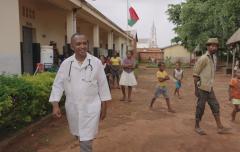Global Push to Power Health Facilities at Energizing Healthcare 2025
Energy, climate and health experts and practitioners came together during the Energizing Healthcare Conference in Nairobi (3-4 February) to accelerate action on powering healthcare facilities in the Global South with clean and reliable energy. The event was co-organized by Sustainable Energy for All (SEforALL) and the Health & Energy Platform of Action (HEPA, hosted by the World Health Organization), in collaboration with the Ministry of Energy of Kenya and the Ministry of Health, Kenya , with support from the UK Government via the Transforming Energy Access (TEA) Initiative.
Nearly 200 participants joined us from across governments, the private sector, philanthropy and civil society to take stock of the trends, barriers and opportunities on health facility electrification. In the midst of a packed two-day agenda, here are some of my takeaways:
- The event provided an opportunity to take stock of the significant progress the sector has made in the last half-decade, in particular during and on the back of the COVID-19 global pandemic. Indeed, many discussions started with how this sector continues to consistently grow, with ever more active stakeholders, additional health facilities being electrified yearly, and a healthy pipeline of funded or planned projects.
- However, the energy access gap in the health sector remains significant. Approximately 100,000 health facilities in sub-Saharan Africa alone either have no access to electricity or are hampered by unreliable electricity, impacting almost 1 billion people. To close the gap, the current estimate is that USD 4.9 billion will be required as a mix of grants, debt and guarantees for capital and operational expenses. To put this into perspective, less than $5 would need to be invested per person currently impacted by the lack of reliable electricity to health facilities.
- A noticeable shift in conversations regarding the health facility electrification sector was around not overly focusing on connections, and more on consumption. The target of powering healthcare is to enable health service delivery. As Dr. Harriet Mwithaga put it, “powering healthcare is not about watts and volts. It’s about heartbeats and hope.”
- Sustainability and the ‘Operations and Maintenance (O&M) conundrum’ featured heavily throughout the conference. Innovative finance mechanisms and delivery models – e.g. Energy-as-a-Service, Distributed Renewable Energy Credits (D-RECs), income-generation activities at the health facility – were all featured and discussed, both for their merits, challenges, and current barriers for scale. For the first time, several of these models are actively being piloted, in the hope that lessons learnt can be replicated to other geographies and scaled to future projects, in parallel with adapting more traditional approaches to ensure long term operation and maintenance.
- Most facilities without electricity are also lacking critical and life-saving medical devices and clean water. If we provide electricity, but that electricity cannot be used due to the for the lack of devices, the health impact of electrification efforts is very limited. It is essential for electrification initiatives to coordinate with provision of life-saving power dependent medical devices and clean water supply solutions.
What is next for this cross-sector coalition of partners focused on healthcare electrification?
SEforALL, WHO, and many other partners will be doubling down on our commitment to seed the sector with scalable solutions and accessible tools building on our decade-long track record. While the access gap in the health sector is large, we hold strong our belief that achieving full and reliable electrification of every health facility in the world is not just an imperative, but it is also feasible by 2030.



